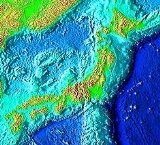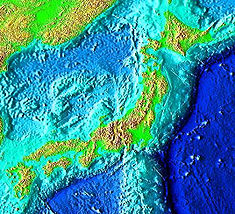
Japan Trench
Encyclopedia
__notoc__
 The Japan Trench is an oceanic trench
The Japan Trench is an oceanic trench
, a part of the Pacific Ring of Fire
, in the floor of the northern Pacific Ocean
off northeast Japan
. It extends from the Kuril Islands
to the Bonin Islands and is 9000 metres (29,527.6 ft) at its deepest. It is an extension of the Kuril-Kamchatka Trench
to the north and the Izu-Ogasawara Trench
to its south with a length of 800 km (497.1 mi). This trench is created when the oceanic Pacific plate
subducts
beneath the continental Okhotsk Plate
. The subduction process causes bending of the downgoing plate, creating a deep-sea trench. Continuing movement on the subduction zone associated with the Japan Trench is one of the main causes of tsunamis and earthquakes in northern Japan
, including the megathrust
Tōhoku earthquake and resulting tsunami
that occurred on 11 March 2011.

Oceanic trench
The oceanic trenches are hemispheric-scale long but narrow topographic depressions of the sea floor. They are also the deepest parts of the ocean floor....
, a part of the Pacific Ring of Fire
Pacific Ring of Fire
The Pacific Ring of Fire is an area where large numbers of earthquakes and volcanic eruptions occur in the basin of the Pacific Ocean. In a horseshoe shape, it is associated with a nearly continuous series of oceanic trenches, volcanic arcs, and volcanic belts and/or plate movements...
, in the floor of the northern Pacific Ocean
Pacific Ocean
The Pacific Ocean is the largest of the Earth's oceanic divisions. It extends from the Arctic in the north to the Southern Ocean in the south, bounded by Asia and Australia in the west, and the Americas in the east.At 165.2 million square kilometres in area, this largest division of the World...
off northeast Japan
Japan
Japan is an island nation in East Asia. Located in the Pacific Ocean, it lies to the east of the Sea of Japan, China, North Korea, South Korea and Russia, stretching from the Sea of Okhotsk in the north to the East China Sea and Taiwan in the south...
. It extends from the Kuril Islands
Kuril Islands
The Kuril Islands , in Russia's Sakhalin Oblast region, form a volcanic archipelago that stretches approximately northeast from Hokkaidō, Japan, to Kamchatka, Russia, separating the Sea of Okhotsk from the North Pacific Ocean. There are 56 islands and many more minor rocks. It consists of Greater...
to the Bonin Islands and is 9000 metres (29,527.6 ft) at its deepest. It is an extension of the Kuril-Kamchatka Trench
Kuril-Kamchatka Trench
The Kuril–Kamchatka Trench or Kuril Trench is an oceanic trench in the northwest Pacific Ocean. It lies off the southeast coast of Kamchatka and parallels the Kuril Island chain to meet the Japan Trench east of Hokkaido...
to the north and the Izu-Ogasawara Trench
Izu-Ogasawara Trench
The , also known as Izu-Bonin Trench is an oceanic trench in the western Pacific Ocean. It stretches from Japan to the northernmost section of Mariana Trench. The Izu-Ogasawara Trench is an extension of the Japan Trench...
to its south with a length of 800 km (497.1 mi). This trench is created when the oceanic Pacific plate
Pacific Plate
The Pacific Plate is an oceanic tectonic plate that lies beneath the Pacific Ocean. At 103 million square kilometres, it is the largest tectonic plate....
subducts
Subduction
In geology, subduction is the process that takes place at convergent boundaries by which one tectonic plate moves under another tectonic plate, sinking into the Earth's mantle, as the plates converge. These 3D regions of mantle downwellings are known as "Subduction Zones"...
beneath the continental Okhotsk Plate
Okhotsk Plate
The Okhotsk Plate is a tectonic plate covering the Sea of Okhotsk, the Kamchatka Peninsula, Sakhalin Island and Tōhoku and Hokkaidō in Japan. It was formerly considered a part of the North American Plate, but recent studies indicate that it is an independent plate, bounded on the north by the...
. The subduction process causes bending of the downgoing plate, creating a deep-sea trench. Continuing movement on the subduction zone associated with the Japan Trench is one of the main causes of tsunamis and earthquakes in northern Japan
Japan
Japan is an island nation in East Asia. Located in the Pacific Ocean, it lies to the east of the Sea of Japan, China, North Korea, South Korea and Russia, stretching from the Sea of Okhotsk in the north to the East China Sea and Taiwan in the south...
, including the megathrust
Megathrust earthquake
Megathrust earthquakes occur at subduction zones at destructive plate boundaries , where one tectonic plate is forced under another. Due to the shallow dip of the plate boundary, which causes large sections to get stuck, these earthquakes are among the world's largest, with moment magnitudes ...
Tōhoku earthquake and resulting tsunami
2011 Tōhoku earthquake and tsunami
The 2011 earthquake off the Pacific coast of Tohoku, also known as the 2011 Tohoku earthquake, or the Great East Japan Earthquake, was a magnitude 9.0 undersea megathrust earthquake off the coast of Japan that occurred at 14:46 JST on Friday, 11 March 2011, with the epicenter approximately east...
that occurred on 11 March 2011.
Miscellany
- On 11 August 1989, the Shinkai 6500 three-person submersible descended to 6526 m (21,410.8 ft) while exploring the Japan Trench.
- In October 2008, a UK-Japan team discovered a shoal of fish, Pseudoliparis amblystomopsisPseudoliparis amblystomopsisThe hadal snailfish, Pseudoliparis amblystomopsis is a species of snailfish, described by Anatoly Petrovich Andriashev in 1955.In October 2008, a team of researchers from the University of Aberdeen's Oceanlab and the University of Tokyo's Ocean Research Institute discovered a shoal of P....
at a depth of 7700 m (25,262.5 ft) in the trench, these are believed to be the deepest living fish ever recorded.
See also
- Oceanic trenchOceanic trenchThe oceanic trenches are hemispheric-scale long but narrow topographic depressions of the sea floor. They are also the deepest parts of the ocean floor....
- Pacific Ring of FirePacific Ring of FireThe Pacific Ring of Fire is an area where large numbers of earthquakes and volcanic eruptions occur in the basin of the Pacific Ocean. In a horseshoe shape, it is associated with a nearly continuous series of oceanic trenches, volcanic arcs, and volcanic belts and/or plate movements...
- Northeastern Japan ArcNortheastern Japan ArcNortheastern Japan Arc also Northeastern Honshū Arc, is an island arc on the Pacific Ring of Fire. The arc runs north to south along the Tohoku region of Honshū, Japan. It is the result of the subduction of the Pacific Plate underneath the North American Plate at the Japan Trench...
- Izu-Bonin-Mariana ArcIzu-Bonin-Mariana ArcThe Izu-Bonin-Mariana arc system is an outstanding example of a plate tectonic convergent boundary. IBM extends over 2800 km south from Tokyo, Japan, to beyond Guam, and includes the Izu Islands, Bonin Islands, and Mariana Islands; much more of the IBM arc system is submerged below sealevel...

